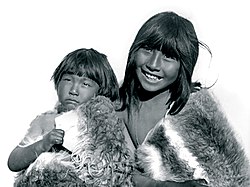Selk'nam people

Selk'nam children, 1898
|
|
| Total population | |
|---|---|
| 505 (2001) | |
| Regions with significant populations | |
|
|
2,761 (2010) |
| Languages | |
| Selk'nam language (Ona) | |
| Religion | |
| Animism, Christianity | |
| Related ethnic groups | |
| Haush, Tehuelche, Teushen | |
The Selk'nam, also known as the Onawo or Ona people, are an indigenous people in the Patagonian region of southern Argentina and Chile, including the Tierra del Fuego islands. They were one of the last native groups in South America to be encountered by migrant ethnic Europeans or Westerners in the late 19th century. With the discovery of gold and expansion of sheep farming, the Argentine and Chilean governments began efforts to explore, colonize and integrate the indigenous peoples of Tierra del Fuego (the "land of fire", named by early European explorers observing smoke from Selk'nam fires) into their cultures.
They are considered extinct as a tribe. Joubert Yanten Gomez, a Chilean mestizo native of Santiago and linguistic prodigy who is of part Selk'nam ancestry, has taught himself the language and is considered the only speaker; he uses the name Keyuk.
While the Selk'nam are closely associated with living in the northeastern area of Tierra del Fuego, they are believed to have originated as a people on the mainland. Thousands of years ago, they migrated by canoe across the Strait of Magellan. Their territory in the early Holocene probably ranged as far as the Cerro Benitez area of the Cerro Toro mountain range in Chile.
Traditionally, the Selk'nam were nomadic people who relied on hunting for survival. They dressed sparingly despite the cold climate of Patagonia. They shared Tierra del Fuego with the Haush (or Manek'enk), another nomadic culture who lived in the south-eastern part of the island. Also in the region were the Yámana or Yahgan.
...
Wikipedia
